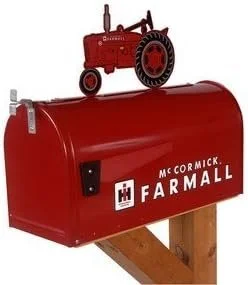Photo by Les Anderson on unsplash
Some people make a personal statement through their clothes, hairstyle, or in the choice of car or truck they drive; some wear a particular style of hat or cut their hair in some unique fashion. Other folks, particularly in rural America, express themselves by decorating their mailboxes.
Travel almost any rural two-lane still frequented by farm machinery and you're likely to come across mailboxes painted with flowers and flags and animals and astrological symbols. Some mailboxes simply have the owner's name scrawled across one side, while others are ornately decorated with bright colors or sculpted in the shape of houses, barns and old railroad engines. You can buy pre-decorated mailboxes, of course. I've seen them painted to resemble barns, tractors, snakes and fish. A clever cat-mailbox design painted the door and inside of the box to resemble the cat's mouth, open and closed, and the mail flag was its swishing tail.
Most interesting, though, are the homemade mailboxes you come across now and then, like the wooden box crafted to resemble a log cabins or the mailbox posted on an old milk can. You'll see many boxes supported in unique ways, such as on the back of a bucking bronc or in the snout of a dragon rising out of a ditch. There's more than one mailbox posted high in the sky on top of a pole for "Air Mail." Others are crafted from old wood stoves, propane gas tanks, barrel drums and even worn-out computers. Any farmer with a welding torch is prone to decorate his mailbox.
Among folklorists, those professionals who study homemade arts and crafts, mailboxes are sometimes called "boundary art." Like gates and entryways, they lie at the edge of one's property and help identify you to the outside world. Whether its a name on the mailbox or a fish leaping over a gateway arch, the symbols say something about who we are, where we live and what we do. A boundary marked with deer or elk skulls, for instance, suggests hunting. Old farm implements spread along a fenceline could celebrate a family farm that's lasted several generations. The folks with the mailbox sculpted out of old horseshoes are probably horse enthusiasts, wouldn't you think?
For folks living in the country, the mailbox is the point from which they make contact with the world outside. Telephones and satellite television and the Internet have removed much of the isolation that came with rural life, but the mailbox is still the conduit through which tangible objects -- things you can hold and feel -- are transmitted back and forth. The mailbox delivers seed catalogs and greeting cards and bills and newspapers and crop payments and invitations and magazines and assorted junk mail; it carries away mortgage payments, order forms, applications, letters to Congress and more greeting cards.
For those in the country, the mailbox is like a signature and the differences in mailboxes can be as unique as the way folks sign their names. Some want theirs spelled out in clean bold block letters; others go for something a little different, like a box mounted to the handle of an old plow or a birdhouse with a canary that comes out and whistles when you open its door.
You gotta admit, it takes all kinds.















